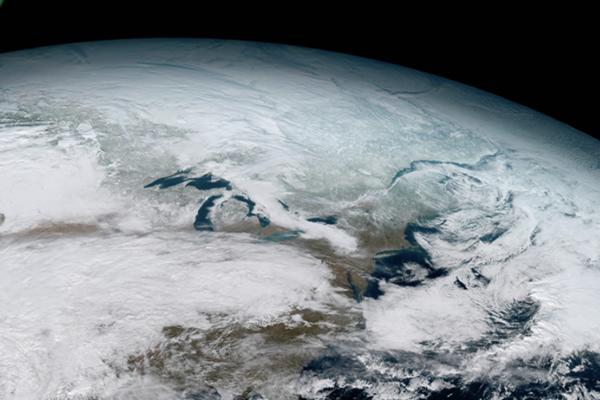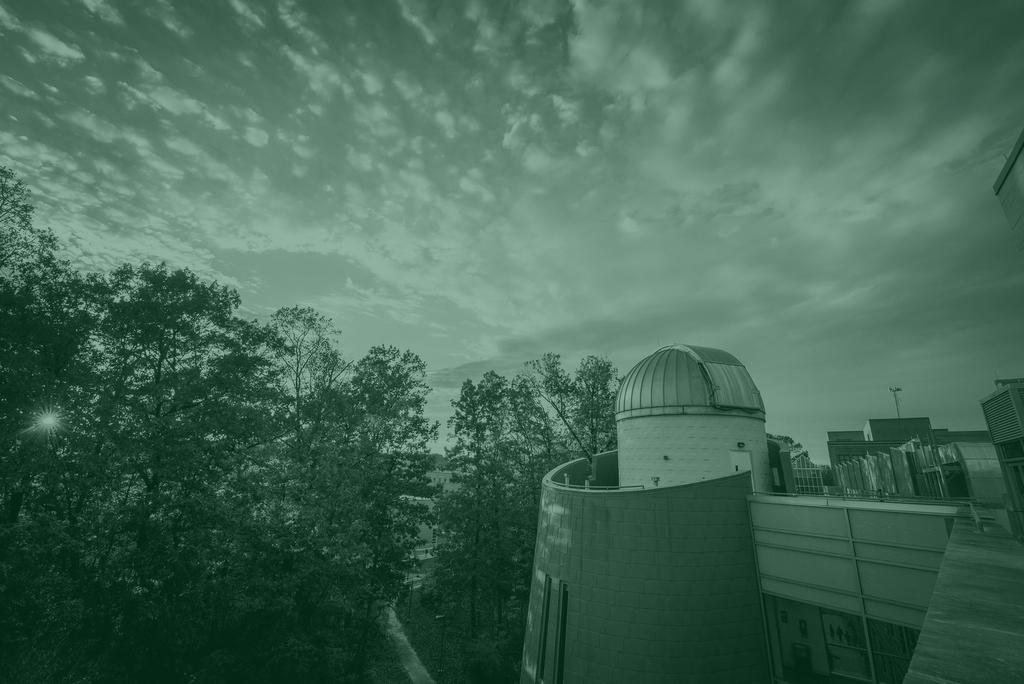Partnering with NASA
Admission CTAs
Partnering with NASA for more than 20 years to solve the world's most challenging problems.

Our faculty are principal investigators on a range of NASA projects.
Explore a few of their projects and labs below.
Earthfinder: A Diffraction-limited Precise Radial Velocity Observatory in Space
Dr. Peter Plavchan is leading a team of 28 scientists from around this world to investigate the science case for a space telescope to search for other potentially habitable Earth-like worlds. Currently, it is only possible to detect Earth-like planets orbiting distant stars using the “transit” or eclipse method, which requires the planets to have just the right orbital tilt to see them. Thus, the nearest “exoplanets” to us are missed, but our mission using the “Doppler Effect” could find them orbiting the nearest stars. If our analysis shows that we can make these discoveries using an observatory in space and that we can outperform future telescopes using the Doppler Effect on the ground, then the astronomy community may make it a priority for us to build and fly this NASA mission in the 2020s. Learn more about Peter’s research group.
Major Updates to the CHIANTI Atomic Database for the Astronomy Community
CHIANTI is a software and data package that is used by hundreds of astronomers worldwide to analyze the data that comes from NASA astronomy missions. Applications include supernovae, galaxy clusters, nebulae, accretion disks and our own star, the Sun. NASA funding for this project makes CHIANTI more accurate and adds features for new applications.
Probing Coronal Heating using Continuous Active Region Observing: New Insights from HINODE, SDO and STEREO
The twin NASA STEREO spacecraft enabled, for the first time, the first 360 degree view of the Sun during 2011-2015. Solar active regions are the source regions of potentially damaging solar storms, and our project used the new STEREO data to track how the regions grow and decay during their full life cycle.
The Jewels in the Crown: Probing Small-scale Energy Supply and Release with the Brightest Active Region Events
NASA’s IRIS satellite was launched in 2013 and it discovered tiny, intense flashes of ultraviolet light that have been named UV bursts. This project led to the PI (Dr. Young) forming an international team of scientists to study these features, allowing us to measure their properties and model how they are produced.
K2 Photometry of QATAR-2B: A Hot Jupiter Orbiting a K Dwarf Amenable to Characterization
The Kepler Space Telescope has discovered over 2000 planets around other stars. The second phase of the Kepler mission (K2) has provided transit observations of giant planets orbiting close to their central stars – known as Hot Jupiters – with sufficient detail to characterize their shapes and thus gravitational tidal interactions with the star. Michael Summers and his students are carrying out this work in order to characterize the planet QATAR-2B.
The NASA New Horizons Mission to Pluto and the Kuiper Belt
The NASA New Horizons Deep Space Mission that carried out a flyby of Pluto in July 2015 provided out first reconnaissance of Pluto. Pluto is one of a belt of an estimated 100,000 similar small ice planets outer solar system and the New Horizons flyby showed that Pluto is an extremely complex planet with active geology and vigorous weather and climate cycles. Michael Summers has been a co-investigator on the New Horizons mission since its proposal to NASA in 1999 and has served as Deputy Lead on the Atmospheres Theme Team. His research on Pluto’s atmosphere is aimed at understanding the chemistry of its hydrocarbon atmosphere as well as its low temperature haze layers that are unique in the solar system. Summers received funding for his role on the New Horizons mission through a sub-contract with the lead instruction the Southwest Research Institute.
The NASA AIM (Aeronomy of Ice in the Mesosphere) mission
The NASA AIM (Aeronomy of Ice in the Mesosphere) satellite is a mission dedicated to studying Noctilucent Clouds – Earth’s highest clouds. These clouds are a by-product of human industrial activity and show strong connections to our rapidly changing climate. Michael Summers has been a mission co-investigator and science team member since its proposal to NASA in 2001. Summers’ role on the AIM mission is the analysis and interpretation of satellite’s observations of Noctilucent Clouds as well as the background atmosphere in order to understand their formation and evolution in addition to their connections to climate change.
Mesosphere and Thermosphere IR and Near-IR Emissions of the Terrestrial and Planetary Atmospheres
Dr. Yiğit has been involved since 2013 in NASA’s MAVEN mission to Mars as a co-participating scientist. He has participated specifically on a MAVEN project to better characterize atmospheric variability and connection between the lower and upper atmospheres using observations. Currently, he is involved in two NASA research projects, one on radiative processes in the middle atmosphere of Earth and the second is on the study of atmospheric waves in Venus’ atmosphere. Systematic modeling and observational studies pertaining to radiative effects and atmospheric waves are crucial in order better understand planetary atmospheres. Learn more about Dr. Yiğit and the space weather lab.
Understanding the Role of Waves and Tides in Regulating Venus’ Highly Variable Upper Atmosphere Circulation (~70 – 170 km)
Dr. Yiğit has been involved since 2013 in NASA’s MAVEN mission to Mars as a co-participating scientist. He has participated specifically on a MAVEN project to better characterize atmospheric variability and connection between the lower and upper atmospheres using observations. Currently, he is involved in two NASA research projects, one on radiative processes in the middle atmosphere of Earth and the second is on the study of atmospheric waves in Venus’ atmosphere. Systematic modeling and observational studies pertaining to radiative effects and atmospheric waves are crucial in order better understand planetary atmospheres. Learn more about Dr. Yiğit and the space weather lab.
Mariner 69 Image / Spice Restoration, Catalog and Archive
Prof. Duxbury heads the NASA, European Space Agency (ESA), Japanese Aeronautics Exploration Agency (JAXA) and Russian Space Agency (Roscosmos) International Phobos/Deimos Surface Characterization and Site Selection Working Group. These two moons of Mars are stepping stones for future robotic and human exploration of Mars. Prof. Duxbury is also an Interdisciplinary Scientist, Co-Investigator and Guest Investigator for NASA on the NASA Mars Odyssey Orbiter, the ESA Mars Express Orbiter, the JAXA Martian Moon Exploration Lander / Return Vehicle and the Roscosmos Luna Globe and Resource orbiter / lander to select landing sites for future robotic and human Mars, Mars moon and lunar missions.
Development and Testing of a Dust Indicator for Climate Assessment in the Western United States
Dust activity is an important indicator to regional climate change. The Dust Bowl in the 1930s was the largest natural catastrophe in the North America history, caused by extended drought and poor land management. Although the severity and duration of the 1930s drought was exceptional, reconstructed paleo-climatic records show that the central U.S. plains have experienced severe droughts about once or twice a century over the past 400 years. The objectives of this project is to develop a climate-quality indicator of local windblown dust storms in the U.S. for the US Global Change Research Program (USGCRP).
Enhanced Dust Indicator (EDI): Guarding Against Future “Dust Bowl”
Recent dust observations have revealed rapid intensification of dust storm activity in the western United States. This trend is also closely correlated with a rapid increase in dust deposition in rainwater and “valley fever” hospitalization in southwestern states. It remains unclear, however, if such a trend, when enhanced by predicted warming and rainfall oscillation in the Southwest, will result in irreversible environmental development such as desertification or even another “Dust Bowl”. This study will extend the previous dust indicator project to: 1) develop an enhanced dust indicator using remote sensing and in-situ observations; 2) identify major drivers of the dust trend; 3) constrain dust prediction capability with NASA models; and 4) integrate NASA data/tools to improve USDA soil conservation capability in a changing climate.
Novel use of Nasa Data with Emission Data Assimilation to Support U.S. National Air Quality Forecasting Capability and WMO Regional Chemical Reanalysis
The World Health Organization estimated that exposures to air pollution in 2012 caused 7 million premature deaths worldwide, making it the single largest environmental risk today. In the United States, over one third of the population lives in areas not attaining the health-based National Ambient Air Quality Standards. This project aims to substantially enhance the nation’s pollution forecasting capability through the development of new data assimilation techniques, including both emission data assimilation and chemical data assimilation. The new data assimilation capability improves air quality forecasting performance and enhances responsiveness of such a tool to air quality and public health managers.
Mining And Utilizing Dataset Relevancy From Oceanographic Dataset (Mudrod) Metadata, Usage Metrics, And User Feedback To Improve Data Discovery And Access
Through the NSF Spatiotemporal Innovation Center hosted at COS, we have built smart data discovery and access capability for NASA JPL PO.DAAC with support from NASA AIST program. We also built one of the largest academic cloud infrastructure for geocomputing with support from NASA Center for Climate Simulations. A big data deep learning platform is in progress with support from NASA Goddard Central Office. These capabilities are integrated to provide a comprehensive framework to enable big data process for mitigating potential impact of Near Earth Object and protecting our home planet with support from NASA PDCO and Goddard.
Integrating Satellite Soil Moisture Into Weather, Emission, And Air Quality Modeling
NASA launched the Soil Moisture Active Passive (SMAP, https://smap.jpl.nasa.gov) in January 2015, which measures the amount of water in the top 5 cm of soil globally. For this project, we use SMAP data to improve local to regional scale weather and air quality forecasts over different regions of the world, including the United States as well as East Asian countries. Our model simulations and analysis also help address key science questions related to NASA airborne campaigns and the next-generation pollution monitoring satellite missions. This project is led by Min Huang, who has participated in a number of NASA Earth Science projects during the past 10 years.
Diagnosis and Validation of Land-Atmosphere Feedback in Two Global Models
In this project, weather and climate models are confronted with NASA environmental analyses, remote sensing and in situ measurements at a range of locations around the world. The goal is to determine if the models used for weather and climate prediction properly represent the interactions between the land surface (e.g., soil moisture, snow, vegetation) and the atmosphere (e.g., temperature, humidity, cloud development and rainfall). Surprisingly, the necessary data to make such assessments on a broad scale has only recently become available. This project is also developing a set of evaluation metrics applicable to both models and the “real world” to understand the physical processes involved in coupling between land and atmosphere, and how they can lead to improved weather and climate prediction.
